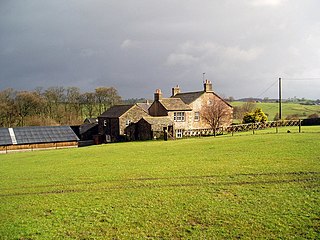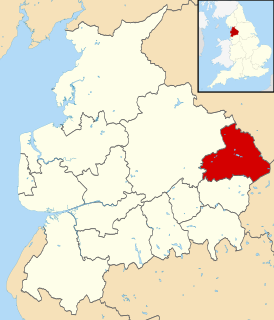
Lancashire is a county in North West England. In 1974 parts of the historic county were divided between Greater Manchester, Merseyside, Cheshire and Cumbria, and part of the West Riding of Yorkshire was transferred into the county, creating the non-metropolitan county of Lancashire. Together with the unitary authorities of Blackburn with Darwen and Blackpool it now forms the ceremonial county of Lancashire.

St Michael's Church is in Bracewell Lane, Bracewell, Lancashire, England. It is an active Anglican parish church in the deanery of Skipton, the archdeaconry of Craven, and the Diocese of Leeds. Its benefice is united with those of Holy Trinity, Barnoldswick, and St Mary le Ghyll, Barnoldswick. The church is recorded in the National Heritage List for England as a designated Grade I listed building.
Bretherton is a civil parish in the Borough of Chorley, Lancashire, England. The parish contains 19 buildings that are recorded in the National Heritage List for England as designated listed buildings. Of these, two are listed at Grade II*, the middle grade, and the others are at Grade II, the lowest grade. Apart from the village of Bretherton, the parish is rural. Most of the listed buildings are, or originated as, farmhouses or farm buildings. The other listed buildings include a medieval cross base, two historic houses, a cottages, a former school a converted windmill, a church, a rectory, and a war memorial
Brindle is a civil parish in the Borough of Chorley, Lancashire, England. The parish contains 26 buildings that are recorded in the National Heritage List for England as designated listed buildings. Of these, two are listed at Grade II*, the middle grade, and the others are at Grade II, the lowest grade. Apart from the village of Brindle, the parish is mainly rural, and a high proportion of the listed buildings are, or originated as, farmhouses or farm buildings. The Leeds and Liverpool Canal passes through the parish, as does the disused southern section of the Lancaster Canal, and there are listed buildings associated with both of these. The other listed buildings are churches and houses, and structures associated with them.
Heskin is a civil parish in the Borough of Chorley, Lancashire, England. It contains 17 buildings that are recorded in the National Heritage List for England as designated listed buildings. Of these, one is listed at Grade I, the highest of the three grades, one is at Grade II*, the middle grade, and the others are at Grade II, the lowest grade. The parish is almost completely rural, and most of the listed buildings are, or originated as, farmhouses and farm buildings. The other listed buildings are large houses and associated structures, and a cottage.
Claughton is a civil parish in Lancaster, Lancashire, England. It contains nine listed buildings that are recorded in the National Heritage List for England. Of these, one is listed at Grade I, the highest of the three grades, one is at Grade II*, the middle grade, and the others are at Grade II, the lowest grade. The parish contains the village of Claughton, and is otherwise rural. Its major structure is Claughton Hall, a country house that was moved from its original site in the village to a more isolated position in 1932–35. The hall is listed, and the other listed buildings include a former wing of the hall that is now a farmhouse, other houses, a barn, a church, a cross base in the churchyard, and a milestone.
Cockerham is a civil parish in Lancaster, Lancashire, England. It contains 19 listed buildings that are recorded in the National Heritage List for England. Of these, two are listed at Grade II*, the middle grade, and the others are at Grade II. Apart from the village of Cockerham, the parish is rural, and most of the listed buildings are houses, cottages, farmhouses and farm buildings. The other listed buildings include a church, the base of a sundial, boundary stones, and a bridge.
Gressingham is a civil parish in Lancaster, Lancashire, England. It contains 14 listed buildings that are recorded in the National Heritage List for England. Of these, one is listed at Grade I, the highest of the three grades, two are at Grade II*, the middle grade, and the others are at Grade II, the lowest grade. Apart from the village of Gressingham and the settlement of Eskrigge, the parish is rural. Almost all the listed buildings are houses and associated structures, farmhouses, and farm buildings. Also listed are a church and a bridge crossing the River Lune on the boundary of the parish.
Leck is a civil parish in Lancaster, Lancashire, England. It contains 21 listed buildings that are recorded in the National Heritage List for England. All of the listed buildings are designated at Grade II, the lowest of the three grades, which is applied to "buildings of national importance and special interest". Other than the small settlement of Leck, the parish is rural. The most substantial building in the parish is Leck Hall; this and associated buildings are listed. Most of the other listed buildings are houses, farmhouses and associated structures. Also listed are a church and stones of various types.
Melling-with-Wrayton is a civil parish in Lancaster, Lancashire, England. It contains 22 listed buildings that are recorded in the National Heritage List for England. Of these, one is listed at Grade I, the highest of the three grades, one is at Grade II*, the middle grade, and the others are at Grade II, the lowest grade. The parish contains the village of Melling and the hamlet of Wrayton, and is otherwise rural. Most of the listed buildings are houses, farmhouses and associated structures. The others include a church and associated structures, and two milestones.
Whittington is a civil parish in Lancaster, Lancashire, England. It contains 39 buildings that are recorded in the National Heritage List for England as designated listed buildings. Of these, three are at Grade II*, the middle grade, and the others are at Grade II, the lowest grade. The parish contains the villages of Whittington, Docker and Newton, and is otherwise rural. Most of the listed buildings are country houses with associated structures, smaller houses, and farm buildings. The other listed buildings include a church with a sundial in the churchyard, buildings on a model farm, three milestones, a boundary stone, and a former school.
Barton is a civil parish in the City of Preston, Lancashire, England. It contains ten listed buildings that are recorded in the National Heritage List for England. Of these, one is at Grade II*, the middle grade, and the others are at Grade II, the lowest grade. The parish contains the village of Barton and surrounding countryside. Running through it is the Lancaster Canal, and a bridge crossing it and an aqueduct are listed. The other listed buildings include farm buildings, milestones, a church, and a cross.
Woodplumpton is a civil parish in the City of Preston, Lancashire, England. It contains 20 listed buildings that are recorded in the National Heritage List for England. Of these, one is at Grade II*, the middle grade, and the others are at Grade II, the lowest grade. The parish contains the villages of Woodplumpton and Catforth, and the smaller settlements of Eaves and Lower Bartle, but is otherwise rural. The Lancaster Canal passes through the parish, and three bridges crossing it are listed. The oldest building in the parish is St Anne's Church; this and four structures associated with it, or nearby, are listed. The other listed buildings are houses and associated structures, farmhouses, and farm buildings.
Grindleton is a civil parish in Ribble Valley, Lancashire, England. It contains 19 listed buildings that are recorded in the National Heritage List for England. All of the listed buildings are designated at Grade II, the lowest of the three grades, which is applied to "buildings of national importance and special interest". The parish contains the village of Grindleton, and is otherwise rural. Most of the listed buildings are houses and associated structures, farmhouses and farm buildings. The other listed buildings are a church, a Quaker meeting house, and a public house.
Thornley-with-Wheatley is a civil parish in Ribble Valley, Lancashire, England. It contains nine listed buildings that are recorded in the National Heritage List for England. All of the listed buildings are designated at Grade II, the lowest of the three grades, which is applied to "buildings of national importance and special interest". The parish is entirely rural, and most of the listed buildings are farmhouses and farm buildings. The other listed buildings are a house, a church and presbytery, and a mounting block.
Samlesbury is a civil parish in the South Ribble district of Lancashire, England. It contains 22 listed buildings that are recorded in the National Heritage List for England. Of these, two are listed at Grade I, the highest of the three grades, and the others are at Grade II, the lowest grade. The parish is mainly rural, and many of its listed buildings are houses, farmhouses and farm buildings. The most important buildings are Samlesbury Hall and the parish church, both of which are listed at Grade I. The other listed buildings include structures associated with the church, a school, a bridge, a church built in the 19th century, and a lodge to the hall.
Aughton is a civil parish in the West Lancashire district of Lancashire, England. It contains 15 buildings that are recorded in the National Heritage List for England as designated listed buildings. Of these, one is listed at Grade I, the highest of the three grades, one is at Grade II*, the middle grade, and the others are at Grade II, the lowest grade. The parish is partly residential, and partly rural. The listed buildings consist of churches, houses, farmhouses and farm buildings, two cross bases, boundary stones, and a war memorial.
Scarisbrick is a civil parish in the West Lancashire district and borough of Lancashire, England. It contains 32 buildings and structures that are recorded in the National Heritage List for England as designated listed buildings. Of these, one is listed at Grade I, the highest of the three grades, and the others are at Grade II, the lowest grade. The most significant building in the parish is Scarisbrick Hall which is listed at Grade I, with several associated structures being listed separately. The parish is a collective of smaller hamlets and is largely rural. Many of the listed buildings are houses, farmhouses or other agricultural buildings that have since been repurposed as dwellings, while the others include a telephone kiosk and the Roman Catholic Church of St Elizabeth.
Dalton is a civil parish in the West Lancashire district of Lancashire, England. It contains ten buildings that are recorded in the National Heritage List for England as designated listed buildings. Of these, one is at Grade II*, the middle grade, and the others are at Grade II, the lowest grade. The parish contains the village of Dalton, and is otherwise rural. Most of the listed buildings are farmhouses, or houses and associated structures, the others being a church, and a landmark in the form of a beacon.
Great Altcar is a civil parish in the West Lancashire district of Lancashire, England. It contains eleven buildings that are recorded in the National Heritage List for England as designated listed buildings. Of these, one is at Grade II*, the middle grade, and the others are at Grade II, the lowest grade. The parish is almost completely rural. Apart from a church, its lychgate, and a war memorial in the churchyard, all the listed buildings are houses, farmhouses and farm buildings.






